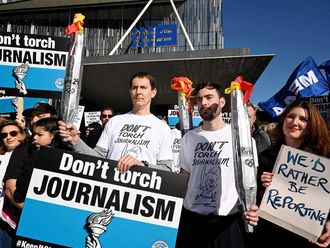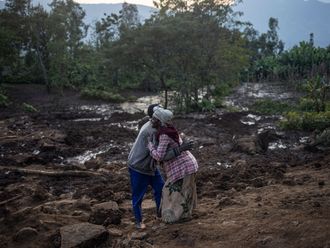Washington: US military leaders have proposed keeping 10,000 troops in Afghanistan after Nato’s combat mission ends in December — or else pull out all American forces, a US official said Wednesday.
The official said that the commander of the Nato-led International Security Assistance Force (ISAF) in Afghanistan, General Joseph Dunford, presented the option last week to the White House, which is weighing the proposal.
“It’s fair to say that the intelligence community, the State Department, the Pentagon, all believe that if we’re going to have a footprint in Afghanistan after 2014, it should be about that number,” said the official, referring to the 10,000 troop level.
“If that can’t be, we also believe it would be most prudent to have nothing,” the official told AFP, speaking on condition of anonymity.
The option being debated by the White House — first reported by The Wall Street Journal and The New York Times — also calls for a short stay for the proposed post-2014 force, which would be scaled back and withdrawn within two years, the official said.
Such a scenario would allow Obama to end the longest US war by the time he leaves office in January 2017.
Security agreement
But the move could prompt accusations of an irresponsible retreat after repeated vows by Washington to maintain an enduring presence in Afghanistan.
Any future force after December still hinges on Afghan President Hamid Karzai signing a bilateral security agreement between the two countries that lays out a legal framework for a US military presence beyond 2014. Karzai has so far refused to sign the deal.
The proposed security pact with Afghanistan would allow US troops to stay through 2024.
The White House acknowledged it was looking at options for a post-2014 force but would not comment on the choices laid out by the Pentagon.
“The president has not yet made decisions about final troop numbers and I’m not going to discuss the details of our ongoing deliberations,” National Security Council spokeswoman Caitlin Hayden said in an email.
“We will be weighing inputs from our military commanders, as well as the intelligence community, our diplomats and development experts as we make decisions about our post-2014 presence in Afghanistan.”
Hayden reiterated that Afghanistan needed to sign the security agreement or else the US government would have to start planning for a complete withdrawal of American and Nato troops from the country.
Under the Pentagon proposal, US commanders hope the 10,000 US troops would be joined by 2,000-3,000 forces from other Nato countries, according to the Journal.
Opposition
Military commanders have reportedly told the White House that if Obama rejects the 10,000 troop option, then all American forces should be withdrawn as a smaller force would be unable to provide security for intelligence officers and diplomats.
Vice President Joe Biden, known for his long-running opposition to a large military presence in Afghanistan, is believed to favour a contingent of less than 10,000, comprised mainly of special operations forces.
But defence officials maintain that the elite special forces would be mostly ineffective without intelligence teams tracking militants to be targeted, according the Journal and the Times.
The discussions echo a 2009 debate on Afghanistan that pitted Biden and some White House officials against the Pentagon, which favoured a surge of troops to break a stalemate with the Taliban insurgency.
The acrimony seriously strained relations between the White House and the military leadership, and a newly released memoir by former defence secretary Robert Gates has provided new details of the feud.
The troop figures put forward last week by the Pentagon are in line with numbers previously cited by top commanders nearly a year ago, in which they estimated an international force of about 8,000 to 12,000 — most of them Americans — after the end of 2014.
About 37,500 US troops are currently on the ground in Afghanistan, along with 19,000 forces from other countries in the Nato-led coalition.
The United States led an invasion of Afghanistan after the attacks of September 11, 2001, quickly toppling the Taliban regime because of its ties to the Al Qaida terror network.
In the years since, the US military, Nato and Afghan forces have waged a protracted campaign against the Taliban and associated insurgents, resulting in a stalemate.










_resources1_16a30b3523c_small.jpg)

